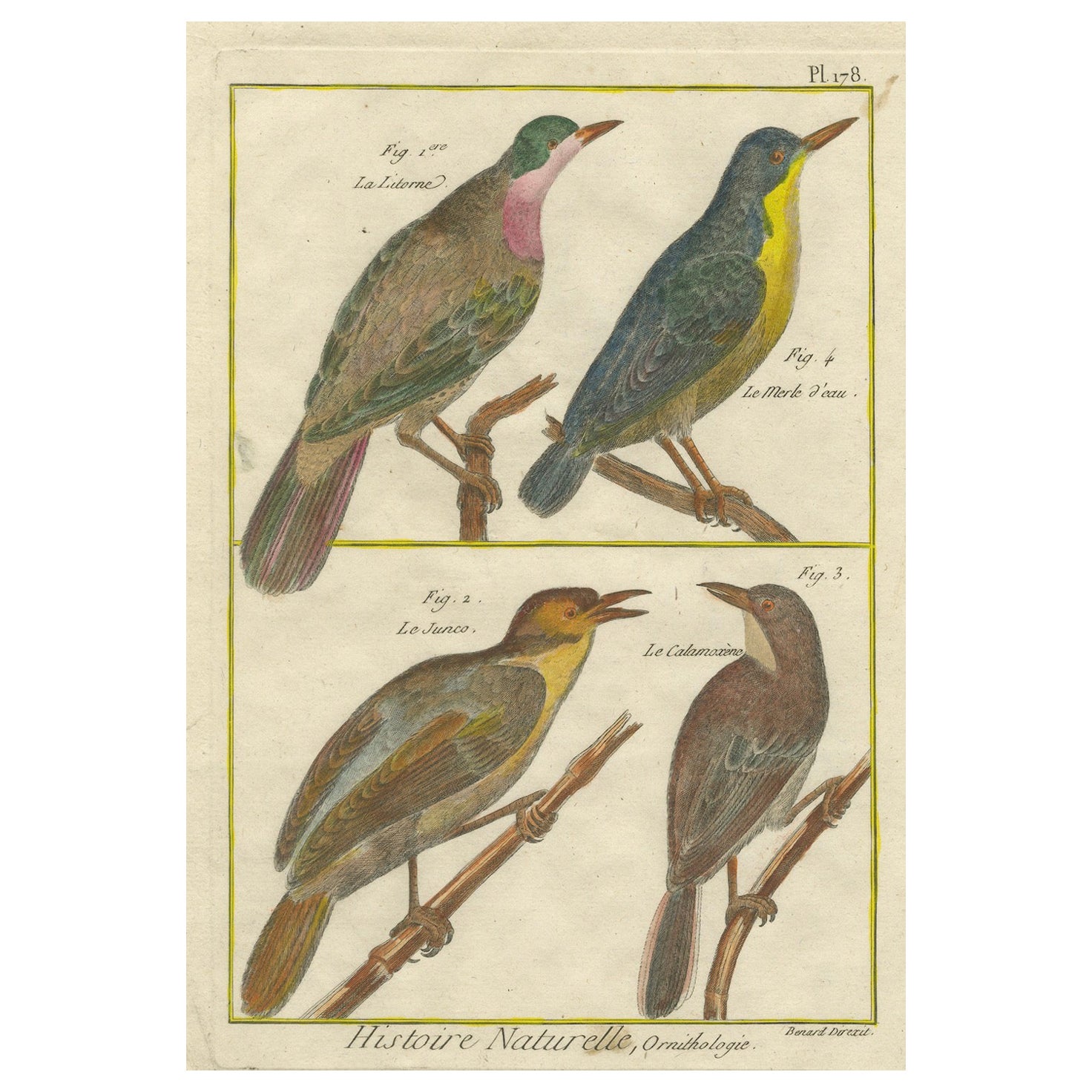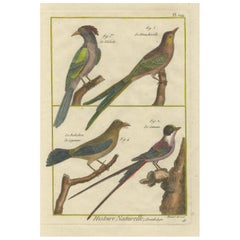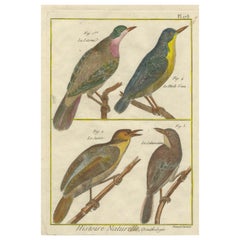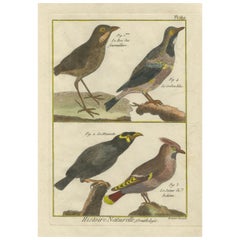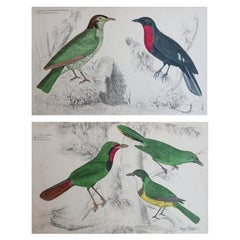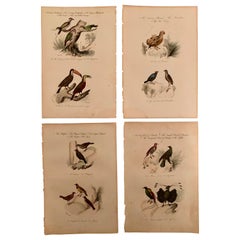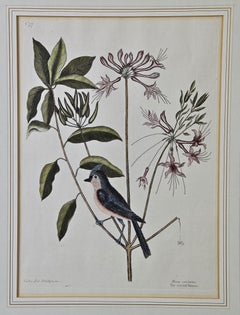Items Similar to Hand-Colored Engraving of Shrike Species from the Caribbean and Southeast Asia
Want more images or videos?
Request additional images or videos from the seller
1 of 6
Hand-Colored Engraving of Shrike Species from the Caribbean and Southeast Asia
$123.74
$154.6720% Off
£92.62
£115.7720% Off
€104
€13020% Off
CA$169.96
CA$212.4520% Off
A$190.03
A$237.5420% Off
CHF 99.68
CHF 124.6020% Off
MX$2,301.75
MX$2,877.1920% Off
NOK 1,258.26
NOK 1,572.8320% Off
SEK 1,188.75
SEK 1,485.9420% Off
DKK 791.78
DKK 989.7320% Off
About the Item
This hand-colored copperplate engraving by Robert Benard, part of the *Histoire Naturelle* from the *Encyclopédie Méthodique*, circa 1790, depicts four distinct species of birds labeled as shrikes (*Pie-grieche*), characterized by their hooked beaks and predatory behavior, typical of the shrike family. The species shown here come from various regions, reflecting the global diversity of the bird family.
Birds Depicted (Translation and Descriptions):
1. Fig. 1: La Pie-grieche à tête noire (Black-headed Shrike):
- This bird represents a black-headed shrike species, possibly similar to the *Red-backed Shrike* (*Lanius collurio*), known for its striking black markings on the head and brownish body. Shrikes are known for their predatory habits, using their sharp beaks to catch insects and small animals. The engraving shows the bird in a dynamic pose, perhaps indicating its readiness to strike.
2. Fig. 2: La Pie-grieche d'Antigue (Antiguan Shrike):
- This bird may represent a shrike species native to Antigua or the Caribbean region. Shrikes in this area are known for their vibrant plumage and territorial behavior. The bird is shown with green and yellow feathers, which suggests a tropical habitat. While specific species may not be widely documented, this bird reflects the exoticism that fascinated European naturalists during the 18th century.
3. Fig. 3: La Pie-grieche Dominicaine (Dominican Shrike):
- The Dominican Shrike likely refers to a species found in the Dominican Republic or the Caribbean. The bird's dark plumage and bright beak are characteristic of shrikes, which typically live in open woodlands or scrublands. The illustration shows the bird perched on a branch, displaying its hooked beak and predator-like demeanor.
4. Fig. 4: La Pie-grieche Panayenne (Panayan Shrike):
- This bird likely refers to a shrike species from the island of Panay in the Philippines. The shrike's greenish plumage and sturdy body reflect the diversity of shrikes in Southeast Asia. Like others in its family, it would inhabit open forests or grasslands, preying on small insects and animals.
Current Habitat and Conservation Status:
- Black-headed Shrike: Shrikes, particularly the Red-backed Shrike, are found across Europe, Asia, and parts of Africa, often inhabiting open woodlands, grasslands, or farmlands. Many species are considered of least concern, but some face habitat loss.
- Antiguan Shrike: Likely an endemic species or subspecies, shrikes in the Caribbean are adapted to the tropical climates of islands, though some populations face threats from habitat destruction.
- Dominican Shrike: Shrikes in the Dominican Republic may not be well-documented today, but like other Caribbean species, they likely inhabit scrublands and open forests.
- Panayan Shrike: Shrikes in the Philippines face pressures from deforestation, though many species remain common in grasslands and agricultural areas.
Printmaking Technique:
The copperplate engraving technique used here captures the fine details of the birds' feathers, beaks, and postures. The hand-coloring adds depth and realism to the illustrations, especially in the contrast between darker and lighter plumage. These engravings were created to educate and fascinate European audiences, who were eager to learn about exotic species from distant lands.
This particular plate showcases the global diversity of shrikes, from the Caribbean to the Philippines, offering a glimpse into the rich variety of bird species that naturalists were beginning to document in the late 18th century.
- Dimensions:Height: 12.21 in (31 cm)Width: 8.67 in (22 cm)Depth: 0 in (0.02 mm)
- Materials and Techniques:Paper,Engraved
- Period:1790-1799
- Date of Manufacture:1790
- Condition:Condition: good, given age. Rough outside the platemark but image is fine. Contemporary hand-colouring. General age-related toning and occasional minor defects from handling. Please study scans carefully.
- Seller Location:Langweer, NL
- Reference Number:Seller: BG-13712-131stDibs: LU3054341463132
About the Seller
5.0
Recognized Seller
These prestigious sellers are industry leaders and represent the highest echelon for item quality and design.
Platinum Seller
Premium sellers with a 4.7+ rating and 24-hour response times
Established in 2009
1stDibs seller since 2017
2,535 sales on 1stDibs
Typical response time: <1 hour
- ShippingRetrieving quote...Shipping from: Langweer, Netherlands
- Return Policy
Authenticity Guarantee
In the unlikely event there’s an issue with an item’s authenticity, contact us within 1 year for a full refund. DetailsMoney-Back Guarantee
If your item is not as described, is damaged in transit, or does not arrive, contact us within 7 days for a full refund. Details24-Hour Cancellation
You have a 24-hour grace period in which to reconsider your purchase, with no questions asked.Vetted Professional Sellers
Our world-class sellers must adhere to strict standards for service and quality, maintaining the integrity of our listings.Price-Match Guarantee
If you find that a seller listed the same item for a lower price elsewhere, we’ll match it.Trusted Global Delivery
Our best-in-class carrier network provides specialized shipping options worldwide, including custom delivery.More From This Seller
View AllHand-Colored Engraving of Exotic Tropical Birds from Histoire Naturelle, 1790
Located in Langweer, NL
This is an hand-colored copperplate engraving by Robert Benard, part of the *Histoire Naturelle* from the *Encyclopédie Méthodique*, circa 1790. The illustration features four exotic...
Category
Antique 1790s Prints
Materials
Paper
$123 Sale Price
20% Off
Hand-Colored Engraving of European & Exotic Birds from Histoire Naturelle, 1790
Located in Langweer, NL
This hand-colored engraving is attributed to Robert Benard (1734-1786) and originates from the *Encyclopédie Méthodique*, published around 1790. It showcases four different birds, de...
Category
Antique 1790s Prints
Materials
Paper
$123 Sale Price
20% Off
Hand-Colored Engraving of Diverse Bird Species from Histoire Naturelle, 1790
Located in Langweer, NL
This hand-colored copperplate engraving by Robert Benard, part of the *Histoire Naturelle* from the *Encyclopédie Méthodique*, circa 1790, showcases four striking bird species. Each ...
Category
Antique 1790s Prints
Materials
Paper
$122 Sale Price
20% Off
Hand-Colored Engraving of African and Malagasy Grosbeaks and Ortolans, 1790
Located in Langweer, NL
This is anexquisite hand-colored copperplate engraving by Robert Benard from the *Histoire Naturelle*, part of the *Encyclopédie Méthodique*, published around 1790. The illustration ...
Category
Antique 1790s Prints
Materials
Paper
$123 Sale Price
20% Off
Hand-Colored Engraving of Warblers and Blackbirds from Histoire Naturelle, 1790
Located in Langweer, NL
This hand-colored copperplate engraving by Robert Benard, part of the *Histoire Naturelle* from the *Encyclopédie Méthodique* (circa 1790), features four species of birds, all repres...
Category
Antique 1790s Prints
Materials
Paper
$123 Sale Price
20% Off
Hand-Colored Engraving of Blackbird Species from Histoire Naturelle, 1790
Located in Langweer, NL
This hand-colored copperplate engraving by Robert Benard, part of the *Histoire Naturelle* from the *Encyclopédie Méthodique* (circa 1790), showcases four species of blackbirds or th...
Category
Antique 1790s Prints
Materials
Paper
$123 Sale Price
20% Off
You May Also Like
Original Antique Bird Prints, Shrike and Fruit Crows. 1847
Located in St Annes, Lancashire
Great images of shrike and fruit crows
Unframed.
Lithographs after Cpt. Brown with original hand color.
Published, 1847.
The measurement is for 1 print
Free shipping
Category
Antique 1840s English Folk Art Prints
Materials
Paper
Original Antique Print of Shrike, 1847 'Unframed'
Located in St Annes, Lancashire
Great image of shrike
Unframed. It gives you the option of perhaps making a set up using your own choice of frames.
Lithograph after Cpt. brown with original hand color.
Published...
Category
Antique 1840s English Folk Art Prints
Materials
Paper
Set of 4 European Hand Colored Prints of Birds from 1830
Located in Haddonfield, NJ
A set of 4 hand colored birds prints, from 1830. By Comte, Achille Joseph (1802-1866),
"Keepsake d´histoire naturelle. Description des oiseaux. Suivie d´un exposé de l art de les pr...
Category
Antique 1830s French Biedermeier Prints
Materials
Paper
$476 Sale Price / set
20% Off
18th Century Catesby Hand-colored Bird & Plant Engraving "The Crested Titmous"
By Mark Catesby
Located in Alamo, CA
A hand-colored copperplate engraving of a bird and plants by Mark Catesby (1683-1749) entitled "The Crested Titmous" from "The Natural History of Carolina, Georgia, Florida and the Bahama Islands", published in 1731. It depicts a small Crested Titmous bird, facing left, perched on the stem of a plant with clusters of mauve colored star-like flowers.
This original Catesby hand-colored engraving, on laid paper with a large central Fleur-de-Lys watermark, is presented in a cream color French mat. The mat measures 20" x 15.5" and the sheet measures 18.75" x 14.75".
Mark Catesby was born in England to a prosperous family, but he traveled to America, first to visit his sister and her husband in 1712. From 1712 to 1719 he explored America observing its birds and plants, taking notes, creating drawings and collecting specimens. He returned to England with this material and created more detailed drawings. His next visit to America 1722-1726 allowed for more detailed research. Upon his return to England he created his monumental and beautiful work "The Natural History of Carolina, Florida, and Bahama Islands", which was published in London in two folio volumes of 11 parts each consisting of 20 plates...
Category
Mid-18th Century Naturalistic Animal Prints
Materials
Engraving
Original Antique Print of Crossbills, 1847 'Unframed'
Located in St Annes, Lancashire
Great image of crossbills
Unframed. It gives you the option of perhaps making a set up using your own choice of frames.
Lithograph after Cpt. brown with original hand color.
Publi...
Category
Antique 1840s English Folk Art Prints
Materials
Paper
Black-Headed Faurette - Etching by Johann Friedrich Naumann - 1840
Located in Roma, IT
Black-Headed Faurette is an Etching hand colored realized by Gotthilf Heinrich von Schubert - Johann Friedrich Naumann, Illustration from Natural history of birds in pictures, publis...
Category
1840s Contemporary Figurative Prints
Materials
Etching
More Ways To Browse
Antique Pie Birds
Delft Large Jars
Double Pendulum
Dovetail Vinyl Record
Dragon Boat
Drexel Chinoiserie
Drexel Precedent
E Drouot
Edward Wormley Precedent
Egyptian Cat
Embossed Copper Box
English Bow Front Chest
English Headboard
English Iron Bed
Folding Travel Clock
Fornasetti Paper
Four Poster Bed Kings
Francois Pompon

